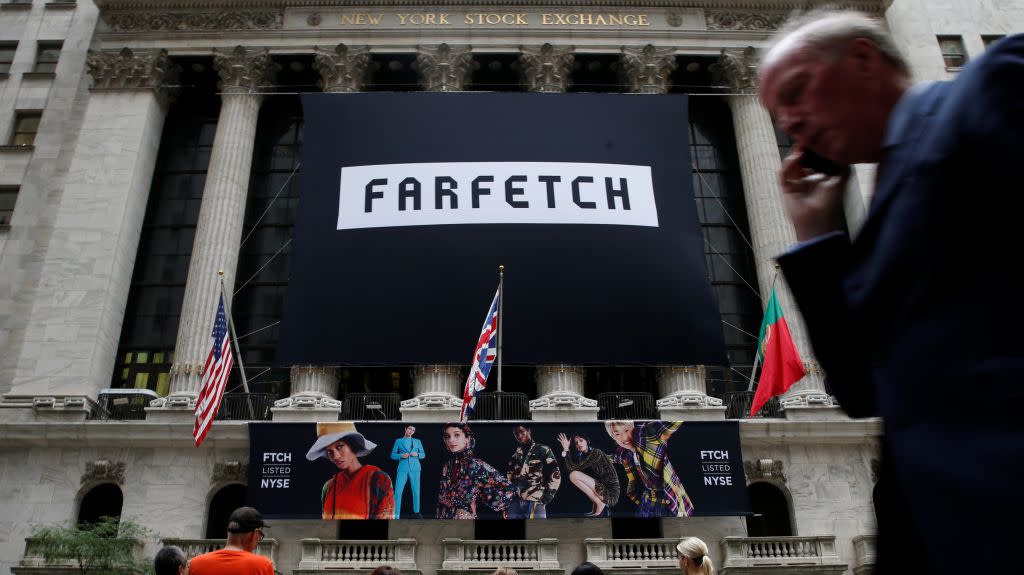Farfetch’s first year as a public company has not gone well

Going public has its tradeoffs. A company can raise a lot of money by listing its shares. But it also becomes beholden to a whole new set of investors, who now shape the company’s story via its stock price. It’s a challenge Farfetch has been grappling with as it approaches the one-year anniversary of its initial public offering.
Farfetch is something like an Amazon marketplace for high-end fashion. It provides a platform for boutiques around the world to sell their wares, without having to carry any inventory itself. Once it had investors excited about its potential to grab a big piece of the growing luxury e-commerce business. Now it has them worrying about its spending and whether it can find a path to profitability.
Farfetch priced its IPO at $20 a share. Since debuting at $27 in September 2018, Farfetch’s shares have been on a rollercoaster, dipping below $20 within a couple of months, rising again a few months later to just under $30, and then plunging to around $11 after the company reported worse-than-expected quarterly earnings on Aug. 8.
The fall has been great enough that five law firms have said they’re looking into class-action suits against Farfetch, alleging the company may have misled investors about its business, The Times (UK) reports. These sorts of legal actions often arise when a company’s share price falls substantially. Typically they don’t amount to much. But it’s undoubtedly a position Farfetch didn’t want to be in—certainly not within its first year as a public company. (Farfetch had no comment when contacted about the allegations.)

By some measures, the company’s performance has been solid. Sales, for example, are still rising quickly. Both its gross merchandise value, which measures how much inventory it has sold, and revenue have been growing at levels at times exceeding 50% year-over-year. The company also has continued to bring more brands onto its platform, such as Jil Sander and Stella McCartney, while expanding the supply of items from existing partners, including Versace and Valentino.
At the same time, Farfetch has been recording losses well in excess of what investors have expected to see. In part they’re the result of a shopping spree that saw Farfetch acquire sneaker reseller Stadium Goods in December for $250 million in cash and stock. Earlier this month, Farfetch announced its purchase of New Guards Group, the exclusive license holder for designer labels including Off-White, Palm Angels, and Marcelo Burlon, for $675 million.
The spending, along with intense pressure to discount products, contributed to a loss of nearly $90 million in the recent quarter, which triggered the stock selloff.

Farfetch has said the deals are investments to help it expand its offering, especially in the hot categories of sneakers and streetwear (paywall), bolstering its own business in the long-term and those of the acquired companies. New Guards Group, for instance, is a “brand platform” that effectively gives Farfetch the tools to easily launch a label from scratch—a fashion equivalent, GQ called it, of Netflix creating original content. The deal will also see Farfetch ramp up the online direct-to-consumer sales of New Guards brands such as Off-White.
But investors seem to feel Farfetch has yet to shore up its core business. In a note to investors, which one of the firms investigating Farfetch even quoted, Wells Fargo analysts noted that Farfetch’s “story has changed meaningfully since the IPO.”
A separate note (paywall) from an analyst at Bernstein remarked, “With its credibility in tatters, it would be important for senior management to come forward with a clearer vision for Farfetch—where clarity and simplicity prevail, and where a definite path to profitability is set.” It added: “In the absence of that, investors are likely to stay on the sidelines, fearing more bad surprises.”
This story has been updated to include the price Farfetch set for its IPO.
Sign up for the Quartz Daily Brief, our free daily newsletter with the world’s most important and interesting news.
More stories from Quartz:

